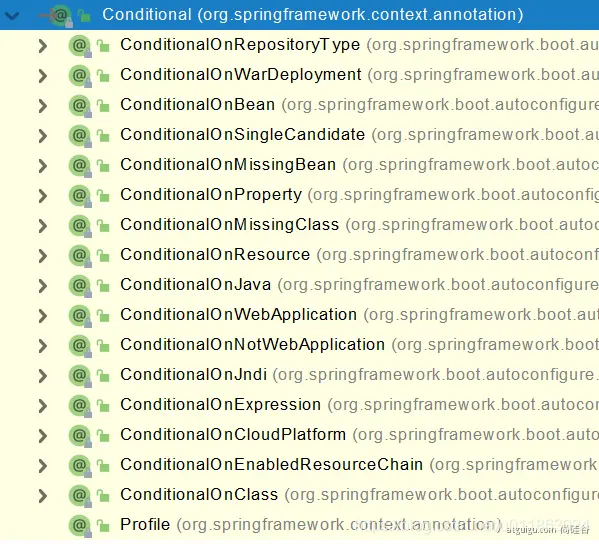 二、SpringBoot的底层注解
二、SpringBoot的底层注解
# 08、底层注解-@Configuration详解
- 基本使用
- Full模式:单例组件
- Lite模式:新创建组件
- 示例
/**
* 1、配置类里面使用@Bean标注在方法上给容器注册组件,默认也是单实例的
* 2、配置类本身也是组件
* 3、proxyBeanMethods:代理bean的方法
* Full(proxyBeanMethods = true)(保证每个@Bean方法被调用多少次返回的组件都是单实例的)(默认)
* Lite(proxyBeanMethods = false)(每个@Bean方法被调用多少次返回的组件都是新创建的)
*/
@Configuration(proxyBeanMethods = false) //告诉SpringBoot这是一个配置类 == 配置文件
public class MyConfig {
/**
* Full:外部无论对配置类中的这个组件注册方法调用多少次获取的都是之前注册容器中的单实例对象
* @return
*/
@Bean //给容器中添加组件。
//以方法名作为组件的id,也就是名字。
//返回类型就是组件类型。
//返回的值,就是组件在容器中的实例
public User user01(){
User zhangsan = new User("zhangsan", 18);
//user组件依赖了Pet组件
zhangsan.setPet(tomcatPet());
return zhangsan;
}
@Bean("tom")//设置bean id为tom
public Pet tomcatPet(){
return new Pet("tomcat");
}
}
2
3
4
5
6
7
8
9
10
11
12
13
14
15
16
17
18
19
20
21
22
23
24
25
26
27
28
29
30
@Configuration测试代码如下:
@SpringBootConfiguration
@EnableAutoConfiguration
@ComponentScan("com.atguigu.boot")
public class MainApplication {
public static void main(String[] args) {
//1、返回我们IOC容器
ConfigurableApplicationContext run = SpringApplication.run(MainApplication.class, args);
//2、查看容器里面的组件
String[] names = run.getBeanDefinitionNames();
for (String name : names) {
System.out.println(name);
}
//3、从容器中获取组件
Pet tom01 = run.getBean("tom", Pet.class);
Pet tom02 = run.getBean("tom", Pet.class);
System.out.println("组件:"+(tom01 == tom02));
//4、当proxyBeanMethods = true时得到的MyConfig bean实际上是一个代理对象com.atguigu.boot.config.MyConfig$$EnhancerBySpringCGLIB$$51f1e1ca@1654a892
// 当proxyBeanMethods = false时得到的bean是com.atguigu.boot.config.MyConfig@194152cf
MyConfig bean = run.getBean(MyConfig.class);
System.out.println(bean);
//如果@Configuration(proxyBeanMethods = true)代理对象调用方法,通过一个代理去调用配置类中方法,即默认单例组件模式。SpringBoot总会检查这个组件是否在容器中有。
//保持组件单实例
User user = bean.user01();
User user1 = bean.user01();
System.out.println(user == user1);
User user01 = run.getBean("user01", User.class);
Pet tom = run.getBean("tom", Pet.class);
System.out.println("用户的宠物:"+(user01.getPet() == tom));
}
}
2
3
4
5
6
7
8
9
10
11
12
13
14
15
16
17
18
19
20
21
22
23
24
25
26
27
28
29
30
31
32
33
34
35
36
37
- 最佳实战
- 配置 类组件之间无依赖关系用Lite模式加速容器启动过程,减少判断
- 配置 类组件之间有依赖关系,方法会被调用得到之前单实例组件,用Full模式(默认)
lite 英 [laɪt] 美 [laɪt]
adj. 低热量的,清淡的(light的一种拼写方法);类似…的劣质品
IDEA快捷键:
Alt + Ins:生成getter,setter、构造器等代码。Ctrl + Alt + B:查看类的具体实现代码。
# 09、底层注解-@Import导入组件
@Bean、@Component、@Controller、@Service、@Repository,它们是Spring的基本标签,在Spring Boot中并未改变它们原来的功能。
@ComponentScan 在07、基础入门-SpringBoot-自动配置特性有用例。
@Import({User.class, DBHelper.class})给容器中自动创建出这两个类型的组件、默认组件的id就是全类名
@Import({User.class, DBHelper.class})
@Configuration(proxyBeanMethods = false) //告诉SpringBoot这是一个配置类 == 配置文件
public class MyConfig {
}
2
3
4
测试类:
//1、返回我们IOC容器
ConfigurableApplicationContext run = SpringApplication.run(MainApplication.class, args);
//...
//5、获取组件
String[] beanNamesForType = run.getBeanNamesForType(User.class);
for (String s : beanNamesForType) {
System.out.println(s);
}
DBHelper bean1 = run.getBean(DBHelper.class);
System.out.println(bean1);
2
3
4
5
6
7
8
9
10
11
12
13
14
15
# 10、底层注解-@Conditional条件装配
条件装配:满足Conditional指定的条件,则进行组件注入

用@ConditionalOnMissingBean举例说明
@Configuration(proxyBeanMethods = false)
//没有tom名字的Bean时,MyConfig类的Bean才能生效。如果这个配置类的bean未生效,那么里面配置的Bean标签都不会生效
@ConditionalOnMissingBean(name = "tom")
public class MyConfig {
@Bean
public User user01(){
User zhangsan = new User("zhangsan", 18);
zhangsan.setPet(tomcatPet());
return zhangsan;
}
@Bean("tom22")
public Pet tomcatPet(){
return new Pet("tomcat");
}
}
public static void main(String[] args) {
//1、返回我们IOC容器
ConfigurableApplicationContext run = SpringApplication.run(MainApplication.class, args);
//2、查看容器里面的组件
String[] names = run.getBeanDefinitionNames();
for (String name : names) {
System.out.println(name);
}
boolean tom = run.containsBean("tom");
System.out.println("容器中Tom组件:"+tom);//false
boolean user01 = run.containsBean("user01");
System.out.println("容器中user01组件:"+user01);//true
boolean tom22 = run.containsBean("tom22");
System.out.println("容器中tom22组件:"+tom22);//true
}
2
3
4
5
6
7
8
9
10
11
12
13
14
15
16
17
18
19
20
21
22
23
24
25
26
27
28
29
30
31
32
33
34
35
36
37
38
# 11、底层注解-@ImportResource导入Spring配置文件
比如,公司使用bean.xml文件生成配置bean,然而你为了省事,想继续复用bean.xml,@ImportResource粉墨登场。
bean.xml:
<?xml version="1.0" encoding="UTF-8"?>
<beans ...">
<bean id="haha" class="com.lun.boot.bean.User">
<property name="name" value="zhangsan"></property>
<property name="age" value="18"></property>
</bean>
<bean id="hehe" class="com.lun.boot.bean.Pet">
<property name="name" value="tomcat"></property>
</bean>
</beans>
2
3
4
5
6
7
8
9
10
11
12
使用方法:
@ImportResource("classpath:beans.xml")
public class MyConfig {
...
}
2
3
4
测试类:
public static void main(String[] args) {
//1、返回我们IOC容器
ConfigurableApplicationContext run = SpringApplication.run(MainApplication.class, args);
boolean haha = run.containsBean("haha");
boolean hehe = run.containsBean("hehe");
System.out.println("haha:"+haha);//true
System.out.println("hehe:"+hehe);//true
}
2
3
4
5
6
7
8
9
# 12、底层注解-@ConfigurationProperties配置绑定
如何使用Java读取到properties文件中的内容,并且把它封装到JavaBean中,以供随时使用
传统方法:
public class getProperties {
public static void main(String[] args) throws FileNotFoundException, IOException {
Properties pps = new Properties();
pps.load(new FileInputStream("a.properties"));
Enumeration enum1 = pps.propertyNames();//得到配置文件的名字
while(enum1.hasMoreElements()) {
String strKey = (String) enum1.nextElement();
String strValue = pps.getProperty(strKey);
System.out.println(strKey + "=" + strValue);
//封装到JavaBean。
}
}
}
2
3
4
5
6
7
8
9
10
11
12
13
Spring Boot一种配置配置绑定:
@ConfigurationProperties + @Component
假设有配置文件application.properties
mycar.brand=BYD
mycar.price=100000
2
只有在容器中的组件,才会拥有SpringBoot提供的强大功能,所有要加上Component注解标识这是一个组件
配置绑定之后会将配置文件中设置的值赋给相同名字的成员变量
@Component
@ConfigurationProperties(prefix = "mycar")
public class Car {
...
}
2
3
4
5
Spring Boot另一种配置配置绑定:
@EnableConfigurationProperties + @ConfigurationProperties
@EnableConfigurationProperties 这个注解需要加在配置类上面
这种方式可以用于第三方包,因为第三方包我们无法在类上加Component注解
- 开启Car配置绑定功能
- 把这个Car这个组件自动注册到容器中
@EnableConfigurationProperties(Car.class)
public class MyConfig {
...
}
2
3
4
@ConfigurationProperties(prefix = "mycar")
public class Car {
...
}
2
3
4
